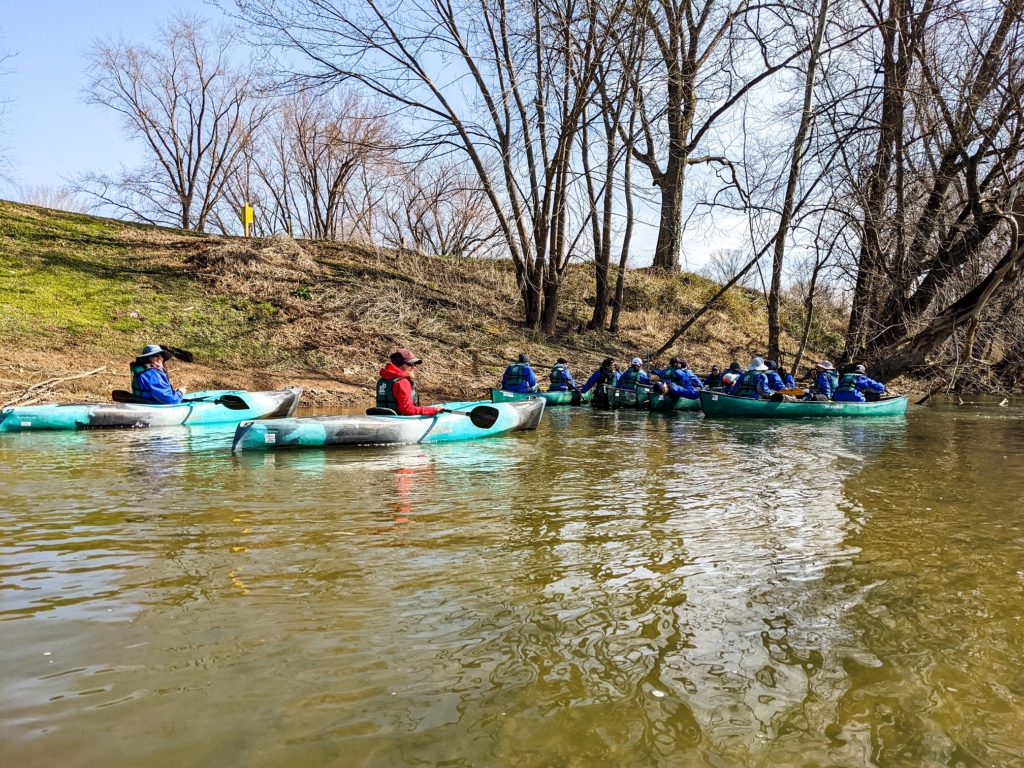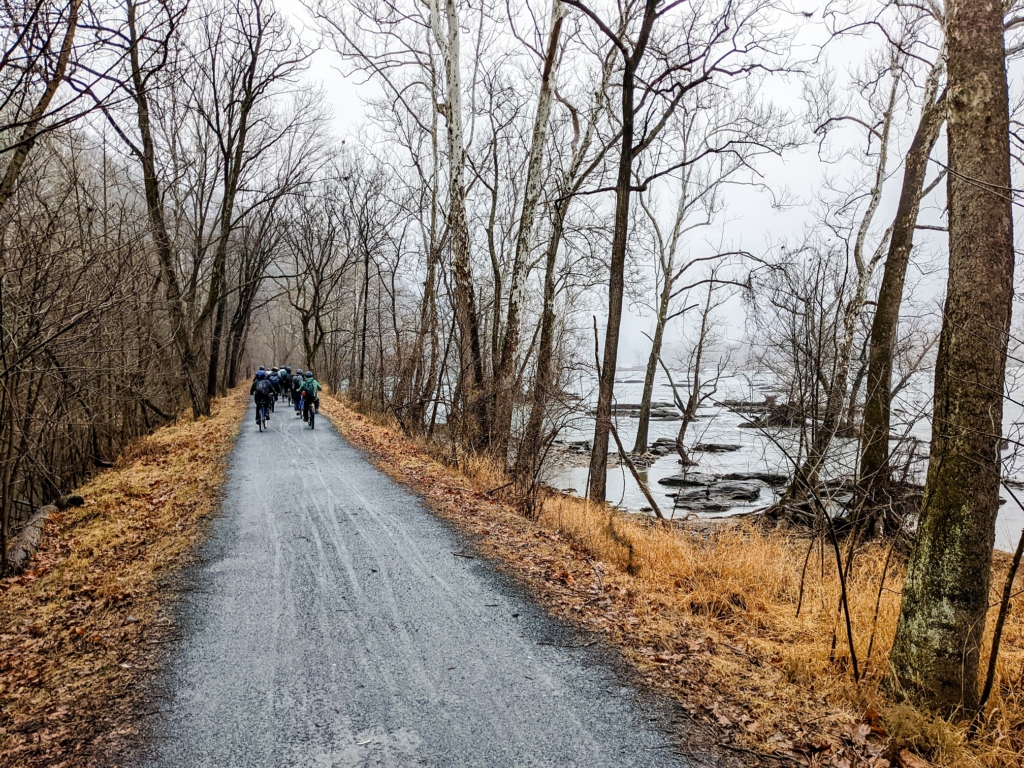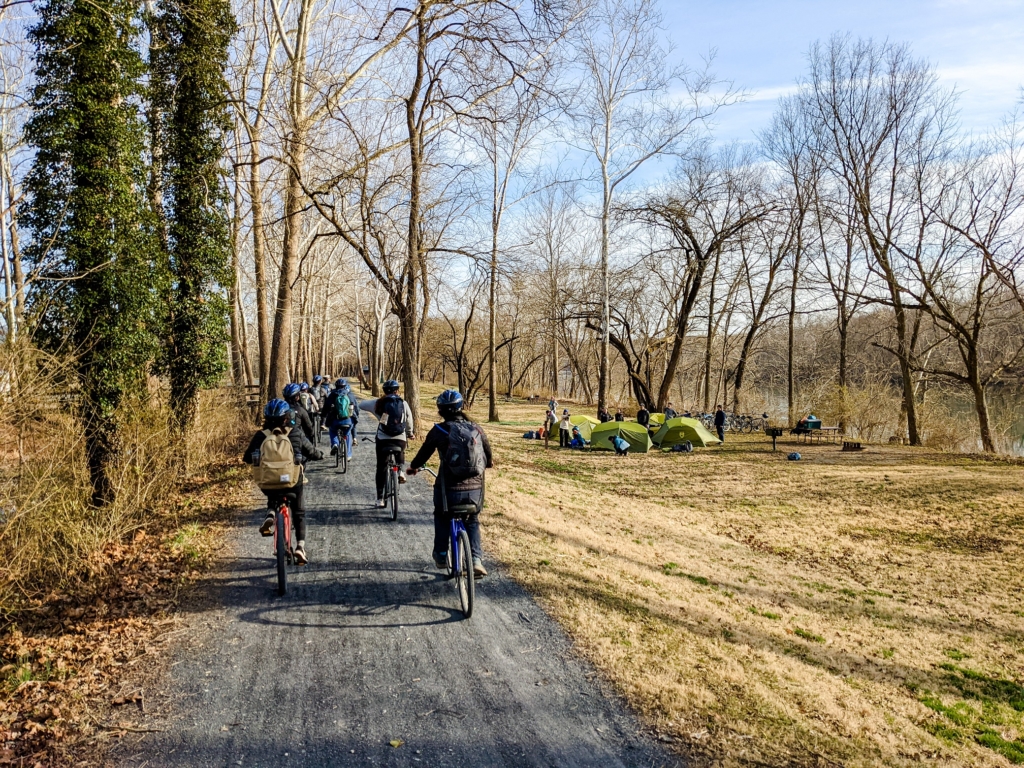
Students in Wharton School’s Climate and Environmental Leadership in Action course paddled 18 miles over two days as part of their five-day wilderness excursion. Photo Credit: Matthias Cape, Venture guide
On the students’ first day canoeing along the Potomac River, Gabriella Gibson was charged with ensuring her team made it to the campsite on time, team members were on pace and healthy, and that they had their tents pitched and meals prepped for the nightly campout. While many other undergrads at University of Pennsylvania’s Wharton School spent their spring breaks getting, well, a break, Gibson was learning concrete lessons on her management style as designated leader of the day.
For one, her high-energy leadership style peppered with a lot of positivity and encouragement made some students feel uncomfortable bringing up concerns for fear of rocking the proverbial canoe. For another, when faced with an obstacle–on the water or leading a business project–sometimes the best course is to ask how she can support team members instead of trying to solve each and every problem herself.
“These leadership mistakes were critical to my growth as both a leader and a more supportive teammate,” says Gibson, one of 20 Wharton undergrads who embarked on a five-day wilderness excursion as part of a new course in spring 2022 to examine both leadership principles and environmental issues as they intersect with business.
“I am grateful to have gained both the experience as a leader as well as feedback on my leadership style so I can work to better myself.”
OUTDOOR EXPERIENCES ‘NECESSARY FOR FUTURE LEADERS’
Climate and Environmental Leadership in Action is Wharton School’s first undergraduate credit course that includes such an excursion as part of its curriculum. The course includes a combination of classroom study and a five-day wilderness trek. For several of the students, some of whom had just come out of COVID-19 seclusion, it was their first prolonged exposure to camping in the great outdoors.

Sarah Light, Associate Professor of Legal Studies & Business Ethics (Courtesy photo)
“I can say with great confidence that student interest, interest in the business community, and interest among faculty has increased dramatically in the intersection of environments and business, specifically with respect to climate,” says Sarah Light, associate professor of legal studies & business ethics who created the course along with Erica Montemayor, director of Wharton Leadership Ventures.
Over five days during spring break, 20 Wharton undergrads cycled 41.5 miles along the Chesapeake and Ohio (C&O) Canal, hiked 3 miles up to Maryland Heights overlooking Harpers Ferry, and paddled 18.6 miles along the Potomac River. In between, they set up their own camps, prepared their own food, and delivered feedback to student leaders who took turns managing the day’s activities.
“I think that it is necessary for future leaders, especially business leaders, to have outdoor experiences because it is not an issue that will go away. In fact, climate change will only increase in importance for the next years and decades, and I think that future leaders will need to be able to understand and handle the environmental responsibilities and risks that every business takes on,” says Christopher Li, a Wharton sophomore studying economics with a concentration in entrepreneurship and business analytics.
“In the same way that it is hard to find business leaders with no technical or general knowledge of computers, it will be just as difficult to find a business leader who does not bear some responsibility in managing their environmental impact.”
WHERE BRICK AND MORTAR LESSONS MEET THE GREAT OUTDOORS
Light has long wanted to teach a course on the relationship between business and the environment that included an outdoors excursion. Before law school, she completed a course with the National Outdoor Leadership School based in Lander, Wyo., that took her deep into the Absaroka Mountains. There, she led a discussion centered on wilderness ethics. The experience was transformative, and she dreamed of offering a similar experience to her business students.
Meanwhile, Wharton Leadership Ventures, part of the McNulty Leadership Program, had for years been guidings MBAs and other students to off-the grid destinations such as Antarctica, Machu Picchu and the Grand Tetons. The Venture team had also been thinking about ways to more directly support students’ classroom learning with an outdoors component. The vice dean of Wharton’s undergraduate programs, Diana Robertson, connected Light with the Ventures team who have been developing the course over the last year.

The excursion included a 41-mile bike ride along the Chesapeake and Ohio (C&O) Canal. Photo Credit: Matthias Cape, Venture guide
The half-credit course is split between five classroom lessons and the five-day wilderness excursion. According to the syllabus, it explores questions such as: What are the greatest challenges in environmental and climate leadership today? How can a firm, nonprofit organization, or individual lead in this space? And how can we integrate environmental and climate considerations into our vision of what makes an individual or an organization a leader?
The classroom piece was designed to introduce themes at the intersection of business, climate and the environment, with lessons on environmental stewardship, creating circular economies, individual and organizational leadership, as well as environmental personhood. Guest speakers included leaders working recycling and those incorporating environmental decision making in their businesses. The outdoors excursion was designed to get students thinking about leadership in extreme environments in order to create actionable solutions in practice, Light tells P&Q.
LEARNING LEADERSHIP IN EXTREME ENVIRONMENTS
There’s ample evidence that being in the wilderness or in other extreme environments brings opportunities for decision making that may not present themselves in a traditional classroom, Light says. In the elements, leaders have to make decisions for the group when they may be hungry, or exhausted, or sopping wet in pouring rain.

Before embarking on the excursion, students completed a High Ropes Challenge Course at The Discovery Center at Fairmount Park in Philadelphia. Photo Credit: Matthias Cape, Venture guide
Each of the Wharton undergrads got the chance to lead their team through a set itinerary. Leaders had to manage getting their team from point A to point B on schedule while making contingency plans in real time. What if someone gets a flat tire? What if it’s raining when it’s time for lunch? How do you manage team members who are exhausted, injured, or lagging behind the pace?
“It’s one thing to discuss leadership principles in the classroom, but to be thrust into a highly uncertain and challenging environment and have to put those principles into practice under high-stress conditions, is an entirely different matter,” says sophomore Caroline Culmo, an international studies major with a concentration in Business, Economics & Public Policy and a minor in Chineses studies.
“These kinds of qualities — adaptability, flexibility, resilience, resolve — are especially key for leaders to develop as they confront an issue as menacing and complex as climate change. Being immersed in the outdoors allows us to develop a deeper appreciation for the environment. It is a powerful reminder of what is at stake — what we have to lose (or gain) — as we work to build a more sustainable future.”
AFTER ACTION REFLECTIONS
Each evening in the wilderness ended with After Action Reflections (AARs), a chance for students to provide real-time feedback to their peer leaders. For Light, the AARs provided some of the most meaningful conversations and insights of the course.
“These are real opportunities for the students to take on a leadership role and to get intensive feedback from their peers about what worked well and what didn’t work,” Light says.
Li agrees.
“It was a great learning experience in balancing the morale of the group with the
logistics and discipline we needed to pack out of camp in time,” Li says. “I would have definitely tried to stay more organized, and one valuable piece of advice that I got in the AAR was to feel free to delegate and seek out help from the group, especially when there are a lot of items that need to be checked off.
“I learned that the leader does not just lead by example, but also through being an effective manager.”

Each night, students set up their own camps, prepared their own food, and participated in After Action Reflections to give peer leaders specific feedback on the day. Photo Credit: Matthias Cape, Venture guide
AT THE INTERSECTION OF BUSINESS AND THE ENVIRONMENT
Apart from the lessons in leadership, being immersed outside–eating, sleeping and moving through the elements for five straight days–sparked deeper conversations about where business and policy meet environmental and climate concerns.
For example, on the venture’s last day, Gibson’s team paddled to the far side of the Potomac so they could officially touch the shore of West Virginia, a state they overlooked or came close to at various points in the adventure, but in which they never officially set foot. This led to a conversation with Prof. Light on ownership, and how different states regulate shared waters, and the myriad of implications different ownership models have on citizens, businesses, and landowners.
“I considered why waterways needed to have rights in the first place. I thought about humankind’s collective inability to recognize that preserving waterways and nature at large is in our best interest and the best interest of future generations,” says Gibson, a first-year undergraduate studying Business, Economics & Public Policy, and marketing. “We have such little faith in society and business to not deplete and destroy these common goods that we must regulate them with laws.”
Those considerations led Gibson to important realizations: First, granting personhood status to various environmental sites is the most promising preservation method we have available. Second, that she wants to pursue environmental advocacy to help preserve waterways like the Potomac and sites she encountered on the trek.
“Being immersed in nature allowed my conversation with Professor Light to take on an increased significance: As we canoed down the river, we saw the smokestacks in the distance and were visibly confronted with the intersection between business policies and environmental impact,” she says. “This was one of the most impactful, reflective, and even therapeutic experiences of my life, and I feel incredibly grateful to have had it.”
DON’T MISS: KELLEY IMPACT COMPETITION, AMPLIFYING STUDENT SOCIAL IMPACT AND MICHIGAN ROSS’ NEW EQUITY ANALYTICS COURSE, DATA WITH IMPACT











Questions about this article? Email us or leave a comment below.